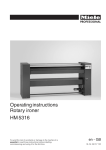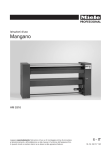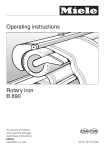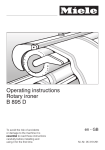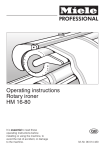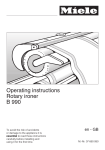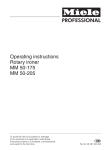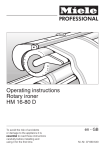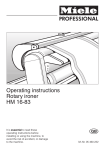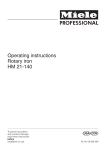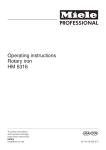Download Miele HM 21-140 Operating instructions
Transcript
Operating instructions Rotary ironer HM 21-140 To avoid the risk of accidents or damage to the machine it is essential to read these instructions before installing, commissioning and using it for the first time. en - GB M.-Nr. 07 799 690 Contents Warning and Safety instructions . . . . . . . . . . . . . . . . . . . . . . . . . . . . . . . . . . . . . . . . . . . . . . . 4 Caring for the environment . . . . . . . . . . . . . . . . . . . . . . . . . . . . . . . . . . . . . . . . . . . . . . . . . . . . 6 Guide to the machine . . . . . . . . . . . . . . . . . . . . . . . . . . . . . . . . . . . . . . . . . . . . . . . . . . . . . . . . . 7 Description of the operating controls . . . . . . . . . . . . . . . . . . . . . . . . . . . . . . . . . . . . . . . . . . . 8 Preparing the laundry . . . . . . . . . . . . . . . . . . . . . . . . . . . . . . . . . . . . . . . . . . . . . . . . . . . . . . . 11 Condition of laundry . . . . . . . . . . . . . . . . . . . . . . . . . . . . . . . . . . . . . . . . . . . . . . . . . . . . . . . . . . 11 Sorting the laundry . . . . . . . . . . . . . . . . . . . . . . . . . . . . . . . . . . . . . . . . . . . . . . . . . . . . . . . . . . 11 Operation . . . . . . . . . . . . . . . . . . . . . . . . . . . . . . . . . . . . . . . . . . . . . . . . . . . . . . . . . . . . . . . . . 12 Ironing . . . . . . . . . . . . . . . . . . . . . . . . . . . . . . . . . . . . . . . . . . . . . . . . . . . . . . . . . . . . . . . . . . . . 12 Notes . . . . . . . . . . . . . . . . . . . . . . . . . . . . . . . . . . . . . . . . . . . . . . . . . . . . . . . . . . . . . . . . . . . . . 15 Preparation of the working area . . . . . . . . . . . . . . . . . . . . . . . . . . . . . . . . . . . . . . . . . . . . . . . . . 15 Emergency release if there is a power cut whilst ironing . . . . . . . . . . . . . . . . . . . . . . . . . . . . . . 15 Cleaning and care . . . . . . . . . . . . . . . . . . . . . . . . . . . . . . . . . . . . . . . . . . . . . . . . . . . . . . . . . . 17 Cleaning the heater plate . . . . . . . . . . . . . . . . . . . . . . . . . . . . . . . . . . . . . . . . . . . . . . . . . . . . . . 17 Roller cover . . . . . . . . . . . . . . . . . . . . . . . . . . . . . . . . . . . . . . . . . . . . . . . . . . . . . . . . . . . . . . . . 17 After Sales Service . . . . . . . . . . . . . . . . . . . . . . . . . . . . . . . . . . . . . . . . . . . . . . . . . . . . . . . . . . . 17 Explanation of symbols on the data plate . . . . . . . . . . . . . . . . . . . . . . . . . . . . . . . . . . . . . . . 18 Important notes for the installer . . . . . . . . . . . . . . . . . . . . . . . . . . . . . . . . . . . . . . . . . . . . . . . 19 Installing the machine . . . . . . . . . . . . . . . . . . . . . . . . . . . . . . . . . . . . . . . . . . . . . . . . . . . . . . . . 19 Exhaust ducting for vapour extraction . . . . . . . . . . . . . . . . . . . . . . . . . . . . . . . . . . . . . . . . . . . . 19 Electrical connection . . . . . . . . . . . . . . . . . . . . . . . . . . . . . . . . . . . . . . . . . . . . . . . . . . . . . . . . 20 M.-Nr. 07 799 690 3 Warning and Safety instructions Technical and electrical safety Before setting up the ironer, check it for any externally visible damage. Under no circumstances should you use it if it has been damaged. A damaged ironer could be dangerous. To avoid the risk of accidents and damage to the ironer please read these instructions carefully before using it for the first time. They contain important information on its safety, use and maintenance. Keep these instructions in a safe place and ensure that new users are familiar with the content. Pass them on to any future owner. Correct application This ironer must only be used for ironing articles which were washed in water and which have a care label stating that the article is suitable for machine ironing. This ironer is not intended for use by persons (including children) with reduced physical, sensory or mental capabilities, or lack of experience or knowledge, unless they are supervised whilst using it or have been shown how to use it correctly by a person responsible for their safety. If the ironer is used in a publically accessible room, it is the supervisor's responsibility to ensure that operators are able to use it safely. 4 If the connection cable is damaged, it must be replaced by a Miele approved service technician. Before connecting the ironer, ensure that the connection data on the data plate (fuse rating, voltage and frequency) match the mains electricity supply. If in any doubt, consult a qualified electrician. The electrical safety of this ironer can only be guaranteed when continuity is complete between it and an effective earthing system which complies with current local and national safety regulations. It is most important that this basic safety requirement is present and regularly tested, and where there is any doubt the on-site wiring system should be inspected by a qualified electrician. The manufacturer cannot be held liable for damage or injury caused by an inadequate earthing system (e.g. electric shock). This ironer complies with all relevant local and national safety requirements. Unauthorised repairs could result in unforeseen dangers for the user, for which Miele cannot accept liability. Repairs should only be undertaken by a Miele approved service technician. Ensure current is not supplied to the ironer until after maintenance or repair work has been carried out. Faulty components must only be replaced by genuine Miele original parts. The manufacturer can only guarantee the safety of the appliance when Miele replacement parts are used. M.-Nr. 07 799 690 Warning and Safety instructions The ironer is only completely isolated from the electricity supply when: – it is switched off at the wall socket and the plug is withdrawn, or – the mains fuse is disconnected, or it is switched off at the mains, or – the screw-out fuse is removed (in countries where this is applicable). Do not damage, remove or bypass the safety features, fixtures and control elements of this appliance. Any removable outer panels must be back in place, and all moving or electrical parts shielded before it is switched on. This ironer may only be used in mobile installations such as ships if a risk assessment of the installation has been carried out by a suitably qualified engineer. Correct use When working with the ironer always wear close fitting clothes. Wide sleeves, apron straps, scarves and ties etc. could be taken in by the roller. Use the swing out bar. It is designed for hanging laundry on. After use it should be swung back out of the way. Take care not to press down on the bar when it is swung out. There is a danger that this could tip the ironer over. Switch the ironer off before removing the plug from the socket. Do not pull it by the cable. Do not lay the connection cable over the heater plate when it is heated up. This could damage the cable - danger of electric shock. Use the cable holders on the ironer to wind the cable away. Using accessories Accessory parts may only be fitted when expressly approved by Miele. If spare parts or accessories from other manufacturers are used, this will invalidate the guarantee, and Miele cannot accept liability. Remove any rings, bracelets, or other jewellery before starting to work. Tie back long hair. When heated up there is an acute risk of burning: – if the heater plate is touched, – if the foot pedal is pressed down while fingers or hands are positioned between the raised heater plate and the roller. This ironer is not a toy! To avoid the risk of injury do not let children play on or near it, or with the controls. Supervise children whilst you are using it. Do not drape laundry over the heater plate when it is heated up. Fire hazard. M.-Nr. 07 799 690 5 Caring for the environment Disposing of the packing material The packaging is designed to protect the machine during transportation. The transport and protective packing has been selected from materials which are environmentally friendly for disposal and can normally be recycled. Rather than just throwing these materials away, please ensure that they are recycled. Ensure that any plastic wrappings, bags, etc are disposed of safely and kept out of the reach of babies and young children. Danger of suffocation. Disposing of your old machine Electrical and electronic machines often contain materials which, if handled or disposed of incorrectly could be potentially hazardous to human health and to the environment. They are, however, essential for the correct functioning of your machine. Please do not therefore dispose of it with your general waste. Please dispose of it at your local community waste collection / recycling centre, or contact Miele for advice. Please ensure that it presents no danger to children whilst awaiting disposal. 6 M.-Nr. 07 799 690 Guide to the machine a Roller speed selector b Heating indicator light % c On/Off button d Start button h 1 b 3 4 1 2 3 4 5 6 Temperature selector Roller Feed-in table Heater plate with finger guard Operating controls Laundry box M.-Nr. 07 799 690 7 8 9 10 11 Ironing table Laundry pick-off unit 4 screw feet (adjustable) Foot pedal switch Heater plate release mechanism (in case of a power cut) 7 Description of the operating controls 0 - I button Roller speed selector Pressing this button switches the machine on or off. The indicator in the button lights up when the machine is switched on. The roller speed is increased by turning the speed selector clockwise and decreased by turning it anti-clockwise. Start button h Temperature selector When this button is pressed, the heater plate will engage and the roller will start rotating. H 40 - 60° C ß - low temperature ßß - medium temperature ßßß - high temperature 8 M.-Nr. 07 799 690 Description of the operating controls Finger guard Foot pedal switch The finger guard is a safety feature and should always be checked before using the ironer. Functions ,Warning. Do not reach between the heater plate and the rotating roller. Danger of injury and burning. Switch position 1 (not pressed down) Ironing Switch position 2 Pressing Switch position 3 Heater plate is withdrawn Press the Start button h The heater plate will lower and the roller will start rotating. When the finger guard is activated the roller stops and the heater plate will disengage. If the finger guard has been activated the machine can only be restarted by pressing the Start button h again. Check that the finger guard is functioning properly. M.-Nr. 07 799 690 9 Description of the operating controls Coin mechanism 1 = Coin slot After a coin or token has been inserted, the pre-set duration will light up in the display. 2 = Coin return button 3 = Coin return 4 = Display 10 M.-Nr. 07 799 690 Preparing the laundry Condition of laundry For a good finish, the ideal residual moisture level is about 25%. Rinsing the laundry using hot water in the final rinse helps to reduce the residual moisture level, and the residual heat in the laundry will help keep processing time down, thus saving energy. Laundry with a synthetic fibre content greater than 50% (e.g. Dralon) must not be ironed as the high temperatures would melt the fabric. Laundry with a lower synthetic content can be ironed at a low temperature. Important Before using the ironer you should clean the heater plate by running a cloth through the entire width of the roller. Useful tips If a tumble dryer is being used, select a "Machine iron" programme. Use warm water if preparation time is short to redampen laundry. Sorting the laundry Before starting to iron, laundry should be sorted according to size and type of fabric. First iron articles made from: perlon, nylon etc. ß - low temperature Then iron woollens and silks ßß - medium temperature Then iron cotton and linen fabrics ßßß - high temperature. If you want to switch back to ironing at a lower temperature, reduce the temperature setting and then wait until the "Heating" indicator light comes on again. Starched laundry should be ironed last to prevent any starch residues on the heater plate from affecting other items of laundry. Items with buttons should be passed through the ironer with the buttons facing into the roller padding. If they face downwards there is a danger of them being damaged or torn off when the item is passed through the ironer. A cloth should be placed over zips, metal buttons and hooks to protect the heater plate during ironing. Metal and plastic buckles and very bulky buttons should not be passed through the ironer. M.-Nr. 07 799 690 11 Operation Ironing ^ Insert the plug in the socket. Check that the finger guard is functioning properly. The finger guard is a safety feature which must be checked daily for proper functioning before the machine is used. ^ Press the 0 - I button. The indicator in the button will light up. Rotary ironers with coin operated mechanism: ^ When the finger guard is activated the roller stops and the heater plate will disengage. ^ If the finger guard has been activated the machine can only be restarted by pressing the Start button h again. The duration will light up in the display. ^ Select the temperature according to the type of fabric. 12 M.-Nr. 07 799 690 Operation Material Symbol Temperature range H 40 - 60°C Polyester / artificial silk ß Low temperature Silk / wool ßß Medium temperature Cottons / linen ßßß High temperature Rotary ironers with coin operated mechanism: ^ Select the roller speed, depending on the degree of dampness and the type of laundry to be ironed. ^ Insert a coin or token. The pre-set duration in minutes will appear in the display. ^ When the "Heating" light % goes out, the ironer is ready for use. ^ Press the Start button h The heater plate will engage and the roller will start rotating. M.-Nr. 07 799 690 13 Operation ^ Release the foot pedal once the item has been placed on the roller. The heater plate will engage. When feeding in thicker items of laundry it is important to avoid putting a strain on specific points of the roller/heater plate. Feed items into the ironer is such a way that that seams, waistbands etc. are not doubled over. Rotary ironers with coin mechanism: ^ Feed items across the feed-in table into the ironer. ^ Smooth items from the middle outwards towards the edges. After the time has elapsed, the heater plate will disengage and the roller will stop. After ironing: ^ If items need to be pressed, press the foot pedal down to switch position 2. The roller will stop. ^ To feed in thick items, press the foot pedal down to switch position 3. The heater plate will disengage. ^ Allow the roller to run for at least 5 minutes on temperature setting H with the heater plate engaged to let the roller cover dry out. ^ Switch off the ironer. ^ Switch off at the mains connection point. 14 M.-Nr. 07 799 690 Notes Preparation of the working area Setting up your working area in as practical and convenient way as possible will ensure greater efficiency when ironing. A height adjustable chair will ensure a comfortable ironing position for all users. The machine should be installed to give maximum light to the feed-in table. Emergency release if there is a power cut whilst ironing If there is a power cut during ironing, to prevent laundry items or the roller cover from being singed, the heater plate can be lifted off the roller by pulling the heater plate release mechanism handle upwards. ^ Switch off the ironer. Place close at hand: – The laundry basket with pre-sorted laundry. – A suitable table for placing ironed laundry on. Small items can be hung over the swing out bar. – Keep a spray bottle of water handy for redamping laundry if necessary. ^ Lift the heater plate release mechanism upwards. The heater plate will lift back from the roller. After the power supply is restored: ^ Switch the ironer on. ^ Press the Start h button. The heater plate will engage and the roller will start rotating. M.-Nr. 07 799 690 15 Notes Protection of the motor and the roller cover Disengage the heater plate during pauses between ironing and when you have finished ironing. This helps prolong the life of the roller cover and protects the motor. It also helps to prolong the life of the machine. It is very important to avoid running the ironer without passing laundry through it. Do not restrict ironing smaller articles to any one part of the roller; make use of the whole roller width. This way an equal amount of heat is obtained from the heater plate and the roller padding is protected from uneven use. Motor protection If the motor winding is heated excessively due to overload, the motor is switched off automatically by a winding thermostat and the heater plate is disengaged. Once the ironer has cooled down, it can be restarted by pressing the I button. 16 M.-Nr. 07 799 690 Cleaning and care The ironer generally requires very little attention. Cleaning the heater plate Limescale and starch deposits can stick to the heater plate. It should therefore be cleaned 1-3 times a week, depending on the degree of soiling. If the steel wool padding needs replacing, this must be done by a Miele authorised service technician. When re-covering the roller, the cover should be between 656 mm and 664 mm wide to ensure that the whole cylindrical width of the roller is covered. For light soiling, clean with Cleanpaste on a wax cloth. Discolouration of the roller cover For heavier soiling, use a cleaning cloth together with a cleaning mat. Some discolouration of the roller cover from light to dark brown is normal. The heater plate should always be waxed after it has been cleaned. To avoid the cover turning black: The special ironer cleaning cloth and wax should only be ordered from the Miele Spare Parts Department. ,Do not use abrasive cleaning agents or abrasive cleaning cloths. – Always use the complete width of the roller. – Space out smaller items, and do not always iron them in the same place. – In pauses between ironing, disengage the heater plate and reduce the temperature. See the Miele Ironing Handbook for more details. After Sales Service Roller cover Before removing the roller cover (for cleaning or replacement) switch the ironer off and disconnect it from the mains. Allow the heater plate to cool down and then remove the laundry feed-in table and use the heater plate release mechanism to raise the heater plate away from the roller. When removing and replacing the roller cover, bits of steel wool will drop onto the ironing table and may get into the gaps around the heater plate supports. These should be covered over. Particles of steel wool should be removed from the ironing table immediately. In the event of any faults please contact your Miele Dealer or the Miele Service Department. When contacting Miele, please quote the Model, Serial number (Fabr.Nr) and Material number (M.Nr) of your ironer. These are given on the data plate. Should you require spare parts ensure that you only use genuine original Miele Spare Parts (and remember to let the Spare Parts Department know the model number and serial number of your ironer). The roller cover should not need washing if it has become slightly yellow, as this is normal. Wash a heavily soiled cover in a 95 °C programme with pre-wash and spin. The roller cover should be wound back on to a moving, heated roller (ß setting) while still damp, with the heater plate engaged. M.-Nr. 07 799 690 17 Explanation of symbols on the data plate a b c d o r p q s e f g t u i j h k l m v w n 1 Model 2 Serial number 3 Article number 4 Material number 5 Voltage/Frequency 6 Mains fuse rating 7 Drive motor 8 Drum data* 9 Drum diameter/Drum depth* 10 Spin speed* 11 Drum volume/laundry dry weight* 12 Kinetic energy* 13 Run-up time* 14 Braking time* 15 Heating 16 Description/Year of manufacture 17 Commissioning date 18 Electric heating 19 Fuse rating (on-site) 20 Steam heating, indirect* 21 Steam heating, direct* 22 Gas heating* 23 Field for Test marks/symbols *) does not apply to this ironer 18 Noise emission Registered on the A scale 67.6 Measured in Germany in accordance with DIN (IEC) 45 635. Machine noise regulations, 3. GSGV § 1. 1.a M.-Nr. 07 799 690 Important notes for the installer The rotary ironer must be commissioned by a Miele authorised service technician. This machine must not be operated in the same room as dry cleaning machines which use solvents containing PERs or CFCs. Escaping vapours could ignite on the motor and form hydrochloric acid which can have dangerous consequences. To ensure optimum flow, the ducting should be laid with as few bends as possible and all connections and joins should be airtight. The connection point for the exhaust ducting is located at the rear of the right hand column. Installing the machine The rotary ironer must be transported on its wooden base to its installation site. Take it off the wooden base at the installation site. ,Ensure that it is stable during transportation. It must not be transported without this wooden base (e.g. when moving it to a new location). To prevent the build-up of condensation in an upward sloping exhaust ducting, a 3-5 mm ø condensate drain should be fitted at the lowest point. This ironer does not need to be secured to the floor. The ducting must have an internal diameter of 70 mm. The machine should be installed to give maximum light to the feed-in table. Ensure that there is sufficient ventilation in the room where the ironer is installed. Use the adjustable screw feet under the side columns to level the machine. Check that the machine is level at the front and back using a spirit level. If the exhaust is ducted into the outside air, the end of the duct should be protected against the weather. An exhaust system ducted into the open air must be situated in such a way that it does not cause a nuisance. Exhaust ducting for vapour extraction Refer to the "Calculation of air outlet, air inlet and ventilation cross sections" booklet. The on-site ducting system and the exit point to the outside must be checked on a regular basis for a build-up of fluff and cleaned, if required. The exhaust ducting to be installed on site must not be directed into any chimney which is used by gas, solid fuel or oil fired appliances. It must also be kept separate from any exhaust system leading from a tumble dryer. The warm, moist exhaust air should be discharged to the outside air by the shortest route possible. M.-Nr. 07 799 690 19 Electrical connection Electrical connection This machine conforms to IEC 335-1 and IEC 335-2-44. The electrical connection may only be carried out by a suitably qualified technician in accordance with local and national safety regulations (BS 7671 in the UK). WARNING THIS APPLIANCE MUST BE EARTHED Connection to the electrical supply must be carried out in accordance with the data plate, wiring diagram, installation diagram and, where applicable, the conversion instructions. The wiring diagram can be found under the cover plate of the right hand side of the machine. The machine is supplied 3N~ ex works. Please ensure that the voltage and frequency of the machine as quoted on the data plate comply with the on-site supply. If it is converted to another voltage, the data place should be marked with a D. Connection should be made via a suitable isolator which complies with local and national safety regulations and which is easily accesible for disconnecting the machine from the electricity supply. Provision must be made on site to switch off all poles. Switches with a minimum all-pole contact gap greater than 3 mm are suitable for isolating the machine. These include circuit breakers, fuses and relays (IEC/EN 60947). The isolator switch should be easily accessible for servicing work. If the machine is disconnected from the electricity supply ensure adequate measures are taken to ensure that the machine cannot be reconnected to the electricity supply until all work has been carried out. The ironer must be disconnected from the electricity supply before it is moved or dismantled. ,After setting up and connecting the machine successfully ensure that the machine is earthed and that all removable outer panels are correctly fitted back into position. ,The heater plate is disengaged as soon as current is supplied. 20 M.-Nr. 07 799 690 M.-Nr. 07 799 690 21 Alteration rights reserved/5009 M.-Nr. 07 799 690 / 00






















